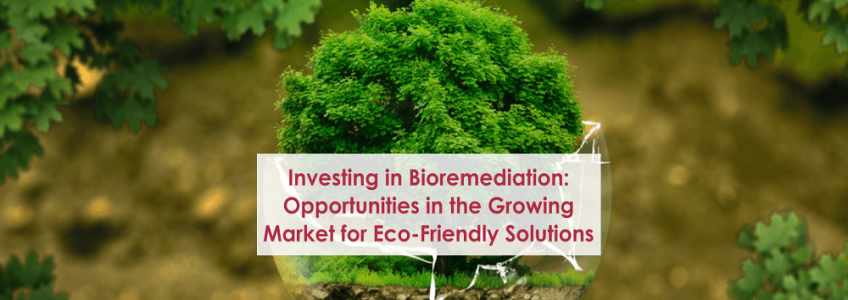The bioremediation industry uses living organisms or their byproducts to clean up and remediate contaminated soil, water, and air. This can be achieved through various methods such as phytoremediation (using plants to absorb or break down contaminants), biostimulation (using nutrients to stimulate the growth of indigenous microorganisms to degrade contaminants), and bioventing.
The industry is growing due to increasing regulatory pressures on companies to properly dispose of hazardous waste and concerns over the environmental impacts of traditional remediation methods such as incineration and chemical treatments. Bioremediation is often seen as a more sustainable and cost-effective alternative.
The market size for bioremediation is expected to reach $11.2 billion by 2024, with a compound annual growth rate of 9.5% from 2019 to 2024. North America and Europe are the largest markets, but the Asia-Pacific region is expected to see the highest growth due to increasing environmental regulations and industrialization.
Suggested Reports for Investments
- Global Bioremediation Technology Market
- Global Microbial Bioremediation Market
- Global Bioremediation Service Market
1. Bioreactors
Bioreactors are specialized vessels or systems used to support the growth and metabolism of microorganisms, often for the purpose of carrying out bioremediation. Bioremediation is using living organisms, such as bacteria or fungi, to break down and remove contaminants from the environment. Bioreactors are designed to provide the optimal conditions for the growth and survival of these microorganisms, including the necessary nutrients, pH, temperature, and oxygen levels. They may be used in various settings, including industrial and agricultural sites, landfills, and polluted bodies of water.
Bioreactors are often used in conjunction with other technologies, such as aeration systems and nutrient supplementation, to enhance the efficiency of the bioremediation process. They are a key tool in environmental restoration and management efforts, as they provide a safe and cost-effective means of removing contaminants from the environment.
2. Biostimulation
Biostimulation is a bioremediation technique that involves using nutrients, oxygen, and other stimulants to promote the growth and activity of naturally occurring microorganisms in the environment. These microorganisms are able to break down and degrade contaminants, such as oil, pesticides, and heavy metals, into non-toxic or less toxic substances. Biostimulation is often used in combination with other bioremediation techniques, such as bioaugmentation (the introduction of specific microorganisms to enhance the bioremediation process) and bioventing (the use of air to stimulate the activity of microorganisms).
Biostimulation is a cost-effective and environmentally friendly approach to remediation, as it relies on natural processes to clean up contaminants rather than chemical or physical treatments. However, it can be less effective in highly contaminated sites or in situations where the contaminants are resistant to degradation.
3. Bioaugmentation
Bioaugmentation is the process of adding specific microorganisms to a contaminated environment in order to enhance the bioremediation process. This is often done when the native microorganisms present in the environment are not capable of effectively degrading the contaminant or when the contaminant is toxic to the native microorganisms. Bioaugmentation and bioremediation can be used in various environments, including soil, water, and air. They are often used to clean up oil spills, hazardous waste sites, and other contaminated areas.
4. Fungal Bioremediation
Fungal bioremediation involves using fungi naturally found in the environment to break down contaminants. These fungi are often adapted to thrive in contaminated environments and can consume and metabolize various organic pollutants. Another method involves introducing specialized fungi strains specifically designed to break down specific types of contaminants. These fungi may be genetically modified or selected for their ability to degrade the contaminant in question efficiently.
Fungal bioremediation can be an effective method for cleaning up contaminated areas. It is often faster and more cost-effective than traditional methods such as excavating and removing contaminated soil. However, it is important to carefully select the appropriate fungi strains and monitor the process to ensure that the contamination is effectively removed and the environment is not further impacted.
5. Phytoremediation
Phytoremediation is a type of environmental cleanup that involves using plants to remove, degrade, or stabilize contaminants in the soil and water. It is a natural and cost-effective way to clean up contaminated sites, as it relies on the plant's natural ability to absorb and process contaminants through its roots and leaves.
There are several different types of phytoremediation, including:
- Phytoextraction: This involves using plants to extract heavy metals and other contaminants from the soil. Some plants, such as sunflowers and mustard plants, are particularly effective at absorbing heavy metals.
- Phytodegradation: This involves using plants to break down contaminants in the soil and water through the process of biodegradation. Certain plants, such as poplars and willows, have been shown to be effective at breaking down contaminants such as pesticides and herbicides.
- Phytostabilization: This involves using plants to stabilize contaminants in the soil, preventing them from leaching into the water supply. Some plants, such as grasses and legumes, are particularly effective at binding contaminants in the soil, making them less likely to leach into the water.
1. Regenesis
Regenesis is a global environmental consulting and remediation company that provides innovative solutions for contaminated soil and groundwater. The company was founded in 1994 and had offices in the United States, Canada, and the United Kingdom. Regenesis offers various services, including site assessment and evaluation, remediation design and implementation, and monitoring and verification. The company aims to help clients restore the environment and protect public health through the use of sustainable and cost-effective solutions. Regenesis has worked on a variety of projects, including oil and gas sites, industrial facilities, and military bases.
2. Xylem, Inc.
Xylem, Inc. is a global water technology company that offers solutions for the bioremediation of contaminated water and soil. Xylem's bioremediation solutions include activated sludge systems,
biofilters, and bioreactors. These systems use microorganisms such as bacteria and fungi to break down contaminants in water or soil, resulting in cleaner and safer water and soil. In addition to their bioremediation solutions, Xylem offers site assessments, design and engineering, and operation and maintenance support. This comprehensive approach helps clients effectively remediate their contaminated sites and protect the environment.
3. Aquatech International LLC
Aquatech International LLC is a company global water treatment company that specializes in providing innovative solutions for
water and wastewater management. They offer a range of services, including site assessment, design, implementation, and monitoring of bioremediation projects for soil and water remediation. They also provide training and consulting services to help clients understand and utilize the benefits of bioremediation. Aquatech International LLC works with clients across various industries, including mining, oil and gas, manufacturing, and agriculture, to help them reduce their environmental impact and meet regulatory compliance standards.
4. Biorem Technologies
Biorem Technologies is a Canadian-based company that specializes in the design, manufacturing, and installation of air pollution control systems for a variety of industries. These systems use advanced technologies such as bio-trickling filters, biofilters, and catalytic oxidizers to reduce the emission of harmful pollutants and odors from industrial processes. The company also provides maintenance and support services for its products to ensure their optimal performance. Biorem Technologies aims to help industries meet environmental regulations and improve their sustainability practices through its innovative air pollution control solutions.
5. Bio-Microbics
Bio-Microbics is a company that specializes in the development and production of advanced wastewater treatment systems. These systems are designed to effectively and efficiently treat and dispose of household, commercial, and industrial wastewater in an environmentally sustainable manner. The company's products include septic systems, greywater recycling, and composting toilets. In addition to providing innovative wastewater solutions, Bio-Microbics also conducts research and development in the field of wastewater treatment and works to educate the public about the importance of proper wastewater management.
There are several ways entrepreneurs can enter the bioremediation industry:
- Research and development: Bioremediation is a relatively new field, and there is still a lot of research and development that needs to be done. Entrepreneurs with a background in biology or environmental science could focus on developing new technologies or techniques for bioremediation.
- Manufacturing and distribution: Bioremediation products such as microorganisms and enzymes are in high demand. Entrepreneurs could start a business that manufactures and distributes these products to customers.
- Consulting and service: Entrepreneurs could also offer consulting and service to companies that need help implementing bioremediation techniques. This could include helping with the design and planning of bioremediation projects, as well as providing technical assistance during the implementation process.
- Investment: Another option for entrepreneurs is to invest in companies that are involved in bioremediation. This could include investing in start-ups that are developing new technologies or techniques or investing in established companies that are already successful in the industry.
- Educating others about bioremediation: There is a need for education and outreach about bioremediation and its potential to clean up contaminated sites. Entrepreneurs can start businesses or organizations that focus on educating others about bioremediation and its benefits.






